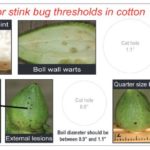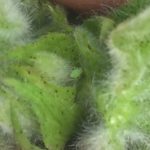Cotton fields range from 2-3 leaf to bloom. Squaring cotton is most prevalent. We are finding cotton fleahoppers in cotton fields across the Mid-Coast. Treat fields based on an economic threshold of 15 fleahoppers per 100 plants.
Watch a video on scouting for cotton fleahoppers HERE.
Cotton fruit retention can be reduced by the cotton fleahopper.
Another factor affecting fruit retention can be the cloudy, wet weather conditions of the past few weeks. The recent weather can make treatment decisions difficult. Just remember to treat based on pest numbers and not just square loss.
As cotton fields begin to bloom and we move into June, the verde plant bug can begin to be found in cotton fields. The adult verde plant bug can be found in fields before the nymphs. These insects are larger than cotton fleahoppers, about 0.5 inch long, and have a reddish marking cross the shoulders.
Verde plant bug nymphs look like large cotton fleahoppers, about twice the size of fleahoppers, and can be distinguished by their red eyes and bands on their antennae.
nymphs look like large cotton fleahoppers, about twice the size of fleahoppers, and can be distinguished by their red eyes and bands on their antennae.
Adult plant bugs may frequently fly in and out of fields on a daily basis. I have seen adult plant bugs in fields one day and been unable to find them the next day. Often they are mating and laying eggs, creating a problem 7-14 days later when their eggs hatch. A field will require treatment when 25 Verde plant bugs are found per 100 plants.
As we begin to see larger bolls, 1 inch in size, it will be time to begin to look for evidence of feeding buy the stink bugs and verde plant bugs.  A boll is usually 1 inch wide 10-12 days after bloom. Look for feeding evidence by pulling twenty five 1-inch bolls from the plant and popping them open to look for staining or wart growth on the inside of the boll wall.
A boll is usually 1 inch wide 10-12 days after bloom. Look for feeding evidence by pulling twenty five 1-inch bolls from the plant and popping them open to look for staining or wart growth on the inside of the boll wall.
The time for sampling the bolls can be shortened by discarding bolls without external spotting. Previous research has found most bolls without external spots do not have internal feeding. First count the bolls with external spots, if the threshold of 20% evidence of feeding has not been reached, look at the bolls without external spots .
.
In the Mid-South and Southeastern U.S., a more dynamic economic threshold is used. The treatment decision is based on the week of bloom as seen below.
| Week of bloom | Threshold (% internal boll damage) |
| 1 | 50% |
| 2 | 30% |
| 3 | 10% |
| 4 | 10% |
| 5 | 10% |
| 6 | 20% |
| 7 | 30% |
| 8 | 50% |

